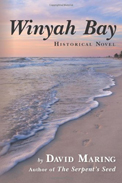"But the bay belongs to no one. Even the present inhabitants will one day disappear, but the bay will remain and always be a magnet to the human species."

 |
Winyah Bay by David Maring CreateSpace
book review by Susan J. Illis
A sweeping historical novel tracing the vast assortment of groups that discovered and settled the South Carolina coast from 1000 CE to the mid-sixteenth century, Winyah Bay couples historical research with speculation into the personal lives of both real and imaginary figures.
The first in a planned trilogy that will incorporate the state's history through the Civil Rights era, the book opens with a surprising archeological discovery—a Viking artifact, lending credence to the theory that European settlers had preceded the Indian migration from the Bering Strait. Using this as an introduction, Maring explores a variety of early residents in the area of the Winyah Bay: fish people, Vikings, Welsh, Spanish, and British. Giving historical perspective and depth to the characters before they make landfall in South Carolina, Maring takes the reader to their homelands and describes their previous lives. These accounts are often more fascinating than their experiences in the New World.
Despite the degradation of women at that time (the novel features more than one arranged marriage, where the groom is chosen based most on what he can give the bride's father), the female characters are primarily strong and determined, different from the stereotypes for their time. Ingri, the Viking woman, for example, runs away from home to marry the sailor Baldar, to whom her father had promised her before receiving a better offer from his dying friend. Ingri, one of the more memorable characters in a book with many, abandons her family and her homeland, but in the end cannot abandon her religious beliefs in favor of a Christian wedding.
In addition to their strength of character, Maring's female protagonists are without exception, comely and willing to use their charms to accomplish their goals, which at that time, primarily means marrying the man they want. While the author's descriptions of Ingri, Ana, Camille, and Bright Star could cynically be interpreted as sexist, they do add interest to the occasionally dry prose and challenge the stereotype, based primarily on the Victorian era, that sexuality was always repressed in the past. Maring's characters have healthy sexual appetites and are not constrained by the modern ideas of marriage and fidelity. The unusual coloring and features of certain groups in the coastal area can be attributed to the amorous activities of the early explorers.
Maring's novel is ambitious and consequently, at times slightly disjointed, as the reader wonders when everything will come together, presumably in one of the future novels. However, those who enjoy historical fiction will appreciate the unique settings and the glimpse of coastal South Carolina's past, while the author lays the groundwork for the more contemporary history in the future books. Because the novel primarily features explorers, much of the action takes place on the water, and the author provides a realistic, unromanticized account of sea travel more than 500 years ago, when sickness, filth, and starvation prevailed. Indeed, this takes an admirable, no-holds-barred approach, making no secret of the differences in personal hygiene necessitated at that time. Maring has crafted an intriguing novel, which despite its primary focus on the South Carolina coast, expertly incorporates Western European history as well.
RECOMMENDED by the US Review